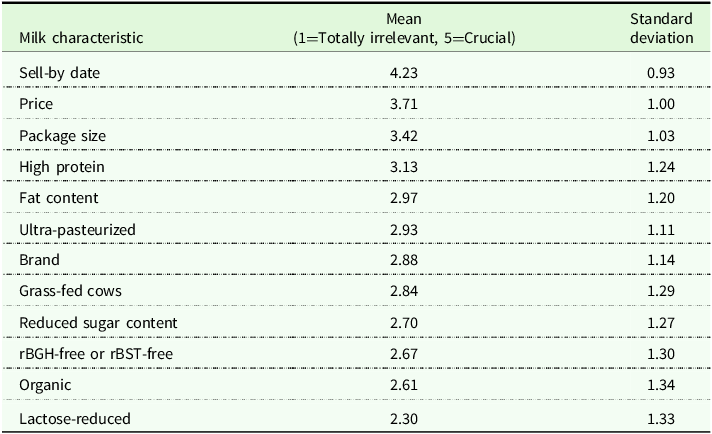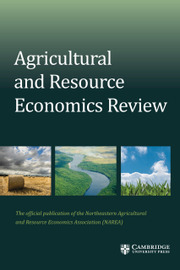Introduction
Dairy cows have been bred for generations to optimize their milk production. It so happens that the cows who excel at milk production also grow horns. In their evolutionary past, horns were advantageous against predators. However, in modern dairy farms, horns are dangerous to other animals and their human handlers (Thompson et al., Reference Thompson, Olynk Widmar, Shutz, Cole and Wolf2017). Thus, producers use disbudding procedures on calves, which involve labor costs and are painful to the animals as their wounds heal. Scientists have identified the gene that causes horns to grow in dairy cows (Canada, Beef Cattle Research Council, 2023, Thompson et al., Reference Thompson, Olynk Widmar, Shutz, Cole and Wolf2017). Recent advancements in clustered regularly interspaced palindromic repeats (CRISPR)-Cas9 gene editingFootnote 1 allow for the modification of a cow’s genome to eliminate horn growth, offering benefits such as reduced animal suffering and lower labor costs (Panko, Reference Panko2016). Despite these benefits and assurances from scientists, governments, and industry regarding their safety, consumers remain skeptical of new food technologies, such as gene editing (Qaim, Reference Qaim2020; Alston and Pardey, Reference Alston and Pardey2021). Therefore, the use of gene editing in dairy cows presents a tradeoff for consumers, weighing the benefits of enhanced animal welfare against the perceived risks associated with consuming milk from gene-edited cows.
Previous research consistently demonstrates that consumers are willing to pay price premiums for foods produced enhancing animal welfare. To this point, information on production practices involving the pain that animals might endure, is likely to cause discomfort among consumers. There is limited research on consumers’ preferences for avoiding information that could cause discomfort. Given individual’s tendency to avoid information that triggers sadness, fear, cognitive dissonance, or uncertainty; one questions whether consumers avoid information concerning productions methods linked to animal welfare.
An objective of this study is to understand how the improvements in animal welfare associated with gene-edited cows are related to consumers’ willingness to pay (WTP) for from such animals. Therefore, in this study, when presenting results, any mention of gene-edited hornless cows is specifically related to pain prevention. We employ a discrete choice format to estimate the WTP for a gallon of milk exhibiting three different labels: milk from dehorned cows, milk from gene-edited cows to prevent painful dehorning, and milk without any indication of dehorning or gene editing.
The study includes three information treatments and a control group. The treatments differ in format and content and include excerpts from a Washington Post article with a questioning tone, social media posts in X (formerly Twitter), and a 4-minute video on gene editing created by scientists. The aim is to improve the understanding of consumer decision-making by presenting both positive and negative viewpoints on gene editing. Importantly, the excerpts used are authentic, reflecting the genuine tone of gene-editing information from each communication channel.
This study offers insights for the dairy industry and policymakers. By gaining a better understanding of consumers’ attitudes and preferences toward gene-edited animals, the industry can make more informed decisions about investing in these technologies. Additionally, these findings can inform regulatory decisions governing gene-edited animals and the products derived from them. It is worth noting that the widespread commercial implementation of gene editing to produce hornless dairy cows has not yet been achieved. As of July 2023, the U.S. Food and Drug Administration has approved the intentional genomic alterations in animals on five instancesFootnote 2 ; however, gene editing for the hornless dairy cows was not among the approved applications (U.S. Food and Drug Administration, 2023).
As a preview of our findings, we estimate that labeling the characteristic of how cows became hornless (i.e., by dehorning or by gene editing) generally decreases consumers’ willingness-to-pay (WTP) for milk. Both milk from gene-edited cows and milk from dehorned cows have lower WTP relative to milk that comes from cows without mention of dehorning or gene editing. The information treatments have differential effects on choices.
Literature review
Gene editing is a breeding technology that consists of identifying specific locations in the DNA sequence and breaks it at specific sites. There are different approaches for gene editing. CRISPR-Cas9 (hereafter CRISPR) is the most popular gene-editing approach due to its ease of use and efficiency (Doudna and Charpentier, Reference Doudna and Charpentier2014). CRISPR applications have the potential to make livestock production more efficient and environmentally sustainable. Besides the potential to improve animal welfare by avoiding horn removal in calves, CRISPR has been used to enhance animals’ resistance to diseases (e.g., pigs that are resistant to porcine respiratory and reproductive syndrome virus), improved animal products quality (e.g., Superfine Merino lambs that produce the highest quality of wool) (Menchaca et al., Reference Menchaca, dos Santos-Neto, Mulet and Crispo2020). CRISPR applications also include treating genetic disorders in animals, expediting livestock breeding, and controlling disease-carrying insects (Barrangou and Doudna, Reference Barrangou and Doudna2016).
Genetic modification and CRISPR offer proven benefits, and there is scientific consensus that the risks from genetically engineered crops and animals to human health, society, and the environment are not greater than the use of conventional breeding. Despite this, consumers remain predominantly skeptical towards these technologies (Qaim, Reference Qaim2020). There is a large body of literature indicating that consumers, in general, are willing to pay to avoid genetically engineered foods (Dannenberg, Reference Dannenberg2009; Lusk et al., Reference Lusk, Roosen and Bieberstein2014; Dolgopolova and Roosen, Reference Dolgopolova and Roosen2018; Huffman and McCluskey, Reference Huffman and McCluskey2021). Regarding gene editing, studies on consumers’ WTP show that individuals, on average, discount gene-edited foods compared to conventionally bred ones (Shew et al., Reference Shew, Nalley, Snell, Nayga and Dixon2018; Muringai et al., Reference Muringai, Fan and Goddard2020; Yang and Hobbs, Reference Yang and Hobbs2020; Marette et al., Reference Marette, Disdier and Beghin2021; Kilders and Caputo, Reference Kilders and Caputo2021; Uddin et al., Reference Uddin, Gallardo, Rickard, Alston and Sambucci2022; Ma et al., Reference Ma, Gallardo, Canales, Atucha, Zalapa and Iorizzo2024). However, when comparing this discount to that of genetically engineered foods, the discount for gene-edited tends to be smaller, albeit with some exceptions (Hu et al., Reference Hu, House and Gao2022). Consumers’ aversion towards any form of genetic engineering, including gene editing, in agri-food production may result in society missing out on the benefits of agri-food research, thereby jeopardizing the ability to sustainably meet the needs of the global population (Lusk et al., Reference Lusk, Roosen and Bieberstein2014; Qaim, Reference Qaim2020; Alston and Pardey, Reference Alston and Pardey2021).
Information plays a role in how the public perceives genetic engineering technologies. Rapid scientific progress can lead to confusion among the public regarding scientific terminology and the reconciliation of the scientific theories with prior knowledge and beliefs. This confusion can lead to misconceptions and misunderstandings (Hansen et al., Reference Hansen, Frewer, Robinson and Sandø2003; Krystallis et al., Reference Krystallis, Grunert, Barcellos, Perrea and Verbeke2012; Bearth and Siegrist, Reference Bearth and Siegrist2016; Siegrist et al., Reference Siegrist, Hartmann and Sütterlin2016; Lusk et al., Reference Lusk, McFadden and Wilson2018, Yang and Hobbs, Reference Yang and Hobbs2020).
The format and framing of the information transfer and the trust in the information source have an impact on consumers’ perceptions and acceptance. Regarding the format and framing of information delivery, narratives stemming from factual and unbiased scientific knowledge have the potential to promote public comprehension and engagement (Yang and Hobbs, Reference Yang and Hobbs2020). On trusted sources of information, U.S. consumers consider health professionals, university scientists, consumer organizations, industry scientists, the regulator, and the media as trusted sources (Lang and Hallman Reference Lang and Hallman2005; Wunderlich and Gatto, Reference Wunderlich and Gatto2015).
Traditional news media coverage affects consumer perceptions of new agri-food technologies and demand for such products (McCluskey et al., Reference McCluskey, Kalaitzandonakes and Swinnen2016). Evidence shows that social media also plays a role in food perceptions and choices. However, the dissemination of information, particularly related to breeding technologies, across traditional media and social platforms, often contradicts the scientific consensus (Yang and Hobbs, Reference Yang and Hobbs2020).
The literature suggests that social media influences vary according to the social media outlet (i.e., Twitter, now called X, versus Facebook) and the extent of public engagement. Using X interactions between experts and their followers on gene editing, Navelski et al. (2025) find that followers opposed to gene editing have substantially more influence than those favoring it. Also, using X data, Tabei et al. (Reference Tabei, Shimura, Kuan, Itaka and Fukino2020) compare U.S. and Japanese consumers’ reactions to gene-edited food and found that the Japanese show an overall negative sentiment compared to Americans.
This study examines consumer reactions to animal welfare and their aversion to animal mistreatment. Previous literature suggests that individuals tend to avoid information they anticipate will cause discomfort. This information avoidance is also called strategic or willful ignorance (Nordström et al., Reference Nordström, Thunström, van’t Veld, Shogren and Ehmke2020). For example, there is evidence that consumers tend to avoid health-related information in foods, such as calorie content (Thunström et al., Reference Thunström, Nordström, Shogren, Ehmke and van ’t Veld2016; Nordström et al., Reference Nordström, Thunström, van’t Veld, Shogren and Ehmke2020). Another example is avoiding information about agricultural production practices that may be harmful to the environment or unpleasant. Li et al. (Reference Li, McCluskey and Messer2018) find that their consumer subjects were willing to pay the most for wine without information on whether it was made with grapes irrigated with recycled water. Bell et al. (Reference Bell, Norwood and Lusk2017) report that avoidance of guilt triggered that about one-third of survey participants admitted being willfully ignorant regarding pork production methods. Reisch et al. (Reference Reisch, Sunstein and Kaiser2021) find that approximately 50% of the survey participants expressed interest in receiving information about foods containing genetically modified organisms and animal welfare concerns related to meat production.
Previous research indicates that consumers are willing to pay more for food products linked to higher standards of animal welfare. Studies by Norwood and Lusk (Reference Norwood and Lusk2011) and Lagerkvist and Hess (Reference Lagerkvist and Hess2011) find that consumers are willing to pay price premiums for meat or eggs from animals not housed in cages or confined spaces. However, these results are heterogeneous across different population segments, with WTP increasing with income and decreasing with age (Norwood and Lusk, Reference Norwood and Lusk2011; Lagerkvist and Hess, Reference Lagerkvist and Hess2011).
The extent of the dehorning issue is significant from a cost perspective. In 2009, 94% of U.S. dairy cattle producers dehorned cattle routinely (U.S. Department of Agriculture, 2009). Costs for traditional dehorning methods range from $6 to $25 per head (Thompson et al., Reference Thompson, Olynk Widmar, Shutz, Cole and Wolf2017), but dehorned cattle often sell at a premium (Morris, Reference Morris2022). Research shows no difference in milk yield or composition between cows with horns and dehorned cows (Baars et al., Reference Baars, Jahreis, Lorkowski, Rohrer, Vervoort and Hettinga2019). Dehorning reduces injury risk, aggressive behavior, and improves handler safety, while also optimizing feeding space (Thompson et al., Reference Thompson, Olynk Widmar, Shutz, Cole and Wolf2017). However, dehorning done after horns are attached to the skull can cause pain, stress, bleeding, fly infestation, and infections. Pain relief methods like anesthetics and analgesics are commonly used (Canada, Beef Cattle Research Council, 2023).
Kilders and Caputo (Reference Kilders and Caputo2021) provide the first analysis of consumers’ valuation of milk from gene-edited cows with consideration of the animal welfare benefits. They find that their participants require a discount for milk from gene-edited cows relative to dehorned cows and cows with horns. Their results include that information on animal welfare has the strongest effect on WTP for milk from gene-edited cows. Our study differs from Kilders and Caputo’s (Reference Kilders and Caputo2021) by presenting the option of milk from cows where there is no information about whether the cow has been dehorned or the dehorning method.
The primary contribution of this paper lies in whether consumers choose to avoid products that provide information regarding the gene editing and agri-food production methods. Specifically, we consider whether the WTP is the greatest for milk from “unspecified” cows, when no information is provided on dehorning or gene editing. Consumers might feel guilt or judged if they knowingly consume a food that inflicts suffering on animals. Thus, our ex ante hypothesis was that many consumers would prefer not to know. The policy implication is that if people are willing to pay for no-information, then policies mandating labeling production methods might not enhance consumer welfare.
Experimental design and data collection
The present study utilized an online survey platform, Qualtrics, to recruit a representative sample of U.S. consumers with the purpose of understanding their preferences for milk from gene-edited cows Footnote 3,Footnote 4 . The survey screened for individuals older than 18 years old, who are responsible at least for 50% of the grocery shopping in the household, and who have purchased or consumed milk in the past 6 months. A between-subjects design was used with four separate versions of the survey based on information treatments, which are discussed below. Between the four versions, 487, 501, 508, and 520 completed surveys were collected, respectively, for a total of 2,016. The survey was administered in February and March of 2023.
The survey included a set of discrete choice experiment questions to analyze consumers’ preference for milk from gene-edited cows. In each choice scenario, respondents were presented with a hypothetical situation in which they were asked to choose to buy from two milk choices or a no-buy option. For each choice scenario, they were presented with a random combination of milk from cows (either traditional dehorned cows, cows that were gene edited to prevent painful dehorning, or unspecified), milk fat (whole and reduced 2%Footnote 5 ), and the price. We opted to include the fat content of milk because previous literature eliciting WTP for milk from cows undergoing alternative technologies include this attribute (Brooks and Lusk, Reference Brooks and Lusk2010). The range of prices was chosen based on current market prices for milk. Price levels were $3.29, $4.29, $4.59, and $4.89 per gallon. Table 1 lists the attributes and attribute levels used, and Figure 1 presents an example of the choice scenario. The participants were also asked about their milk preferences, media habits, attitudes towards animal welfare, knowledge of and policy preferences for gene editing, and sociodemographic questions. To be comparable, the animal welfare questions follow Kilders and Caputo (Reference Kilders and Caputo2021).
Table 1. Attributes and attribute levels used in the experimental design of the discrete choice experiment
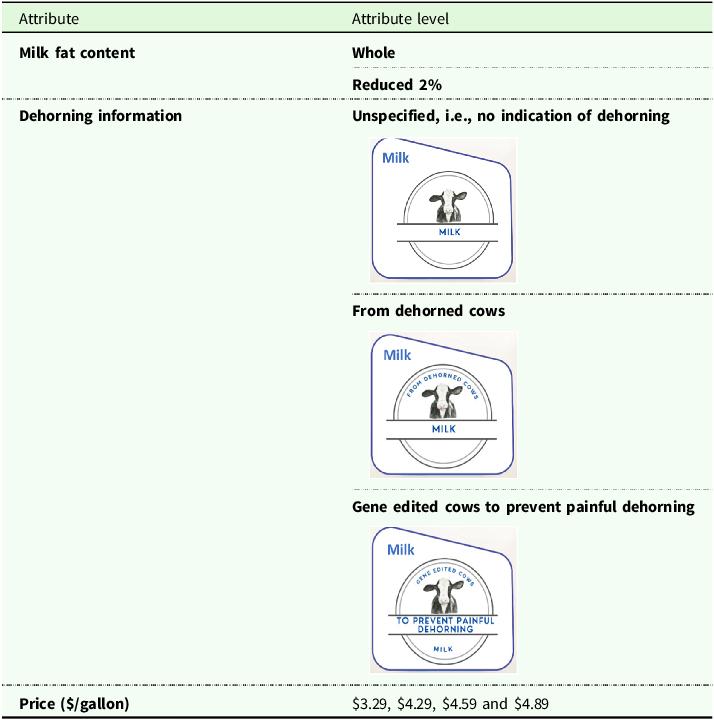

Figure 1. Example of choice experiment.
Each scenario’s random combination of attributes originates from an efficient factorial design. The SAS® macro function %MktEx was used to find all possible combinations of attribute levels. This macro uses an optimization algorithm in an iterative process to optimize the D-efficiency. A larger D-efficiency implies smaller standard errors of the parameter estimates. A perfect design is orthogonal (all parameter estimates are uncorrelated), balanced (all the levels within each attribute occur with the same frequency), and has 100% D-efficiency. After all possible combinations were created (3× 2×4), the %ChoicEff macro was used to find the most efficient design for the choice experiment. In an efficient design, the variances of the parameter estimates are minimized, given assumed values for them. Since this study uses no priors, these values were set to zero (SAS Support, 2023). The study’s design produced a total of 24 final choice sets, organized into three blocks, with a D-efficiency of 17.76. Each block comprised eight discrete choice scenarios, which were randomly assigned to respondents.
To mitigate hypothetical bias, this study used two methods. One is “cheap talk,” following Champ et al. (Reference Champ, Moore and Bishop2009). The following script was used: “Please keep in mind that studies have shown that answering a question about a hypothetical purchase decision, as if the purchase is for real, is difficult for many people. Usually, survey respondents are more likely to state that they would buy a product when responding to a survey than when the purchase decision is real, and they have to pay for the product. This happens because respondents might think, ‘Sure, I will buy this product’, but when the decision actually involves digging into their pockets to pay for it, respondents might think instead, ‘Do I really want to spend my money on this product?’ We ask you try to avoid this situation and answer the following questions as you would if were really shopping at the store and paying for a gallon of milk.”
The second method involved employing a certainty scale, which respondents completed after each discrete choice scenario question. This consist of using a certainty index that ranged from zero (very uncertain) to ten (extremely certain), where respondents report how certain they are about the choice made in the discrete choice experiment (see Figure 1). In this study, a rank of seven or above is considered as certain. Several studies report that the use of a follow-up certainty scale can be effective at mitigating the difference between actual and hypothetical WTP (Champ et al., Reference Champ, Moore and Bishop2009; Morrison and Brown, Reference Morrison and Brown2009; Hensher et al., Reference Hensher, Rose and Beck2012; Beck et al., Reference Beck, Rose and Hensher2013; Rose et al., Reference Rose, Beck and Hensher2015, Beck et al., Reference Beck, Fifer and Rose2016).
The survey included other questions related to media habits, preferences for milk characteristics, attitudes towards animal welfare, perceptions of breeding technologies and policies, and sociodemographic information. Additionally, two attention checks we incorporated to ensure respondent engagement and enhance data quality.
Information treatments
Our information treatments aim to understand how different information sources and content influence consumers’ choices of milk from gene-edited cows. These treatments include: (1) no additional information, (2) information from a newspaper article, (3) information from social media, and (4) information from a video made by scientists for a public audience.
As outlined in the introduction section, this study employs authentic excerpts from media and social media to accurately reflect the authentic tone of gene-editing information disseminated across various channels. We acknowledge that this approach does not allow us to control other factors influencing consumer perceptions. These factors encompass, but are not limited to, the authors’ names, affiliations (including universities and scientific institutions, including animal scientists), retweet counts, hashtags, mentions/likes, illustrations within the tweet, and the elements included in the video, such as audio, duration, and visual aids. The printed information treatments are included in Appendix B, along with a link to the science video. Respondents were randomly assigned to each treatment group.
Traditional news media coverage affects consumer perceptions of food made with new technology and demand for products. Newspapers often emphasize perceived risks in their coverage of new technology in food (McCluskey et al., Reference McCluskey, Kalaitzandonakes and Swinnen2016). The Washington Post article examines how an actual newspaper article affects consumers’ choices. The excerpts delve into consumer skepticism and regulatory issues. Using actual news coverage provides insights into consumer responses but considering results with and without consumer skepticism is also valuable.
We are also interested in how social media affects consumer choices. Consumers can follow social media influencers, leading to customized information flows. This may result in less diverse newsfeeds compared to traditional media, as consumers often follow like-minded people and companies. Navelski et al. (2025) found that anti-gene-editing experts had greater influence on Twitter/X than pro-gene editing influencers. Our Twitter/X information treatment includes four actual posts from a graduate student, a professor, a U.S. government employee, and the Alliance for Science.
The science video presents information from a scientist’s perspective and is more positive towards gene editing. Further, this video discusses why dehorning is needed, the dehorning processes, and implications for animal welfare. It explains how gene editing can be used in place of traditional dehorning methods. Several other studies, including Kilders and Caputo (Reference Kilders and Caputo2021), use videos to communicate scientific information in an easier-to-digest format. Previous studies have shown that consumers trust from scientists more than the media for information about new technology in food (Huffman et al., Reference Huffman, Rousu, Shogren and Tegene2004). The respondents in this information treatment were not allowed to progress in the survey until after the entire 4-minute and 15-second video was played.
Econometric specification
We estimate survey participants’ preferences and WTP for milk attributes including the dehorning method the cows had experienced, by using a generalized multinomial logit model (Fiebig et al., Reference Fiebig, Keane, Louviere and Wasi2010). This model is rooted in the Lancaster’s consumer demand theory (Lancaster, Reference Lancaster1966), and the random utility theory (McFadden, Reference McFadden and Zarembka1974). This theory assumes consumer’s utility is composed of a deterministic component given by the goods attributes and a random component, given by unobserved factors (McFadden, Reference McFadden and Zarembka1974). This utility can be specified as
where
![]() ${U_{nij}}$
is the utility derived by respondent n when choosing alternative i, in scenario j,
${U_{nij}}$
is the utility derived by respondent n when choosing alternative i, in scenario j,
![]() ${\alpha _i}$
is the alternative specific constant (ASC) denoting the opt-out option;
${\alpha _i}$
is the alternative specific constant (ASC) denoting the opt-out option;
![]() ${x_{nij}}$
denotes both the price attribute and the milk attributes: reduced vs. whole milk fat content, dehorned label, gene-edited to prevent painful dehorning, and no information about dehorning;
${x_{nij}}$
denotes both the price attribute and the milk attributes: reduced vs. whole milk fat content, dehorned label, gene-edited to prevent painful dehorning, and no information about dehorning;
![]() ${\beta _n}$
is a vector of coefficients randomly distributed across respondents and assumed to follow a multivariate normal distribution with density
${\beta _n}$
is a vector of coefficients randomly distributed across respondents and assumed to follow a multivariate normal distribution with density
![]() $f\left( {{\beta _n}{\rm{|}}\theta } \right)$
, where
$f\left( {{\beta _n}{\rm{|}}\theta } \right)$
, where
![]() $\theta $
is the true parameter vector of the distribution; and
$\theta $
is the true parameter vector of the distribution; and
![]() ${{\rm{\varepsilon }}_{nij}}$
is an unobserved error term that is assumed to be identically and independently distributed (Train, Reference Train2009).
${{\rm{\varepsilon }}_{nij}}$
is an unobserved error term that is assumed to be identically and independently distributed (Train, Reference Train2009).
This study estimates the WTP space by applying the Generalized Multinomial Logit Model (G-MNL) specification.Footnote 6 The GMNL model incorporates consumers’ preference heterogeneity as follows
where
![]() ${\sigma _n}$
is the individual-specific scale of the idiosyncratic error term that represents the scale heterogeneity, which follows a log-normal distribution with mean
${\sigma _n}$
is the individual-specific scale of the idiosyncratic error term that represents the scale heterogeneity, which follows a log-normal distribution with mean
![]() $\bar \sigma $
and standard deviation τ.
$\bar \sigma $
and standard deviation τ.
![]() ${\eta _n}$
is the vector of individual specific taste that represents the individual’s residual preference heterogeneity,
${\eta _n}$
is the vector of individual specific taste that represents the individual’s residual preference heterogeneity,
![]() $\gamma $
is a parameter between 0 and 1 that controls how the variance of residual taste heterogeneity
$\gamma $
is a parameter between 0 and 1 that controls how the variance of residual taste heterogeneity
![]() ${\eta _n}$
varies with the scale heterogeneity
${\eta _n}$
varies with the scale heterogeneity
![]() ${\sigma _n}$
. This study uses the GMNL Type II (GMNL-II) where γ equals zeroFootnote
7
.
${\sigma _n}$
. This study uses the GMNL Type II (GMNL-II) where γ equals zeroFootnote
7
.
Next, expression (2) can be rewritten, as follows,
where
![]() ${U_{nij}}$
is the utility respondent n derives from choosing alternative i among j alternatives,
${U_{nij}}$
is the utility respondent n derives from choosing alternative i among j alternatives,
![]() ${\rm{AS}}{{\rm{C}}_{ni}}$
is the coefficient estimate for the alternative specific constant,
${\rm{AS}}{{\rm{C}}_{ni}}$
is the coefficient estimate for the alternative specific constant,
![]() ${p_{{\rm{nij}}}}$
is a continuous variable denoting price that was normalized to -1. By normalizing the coefficient of price to -1, one can interpret the coefficients of other non-price attributes as the WTP estimates.
${p_{{\rm{nij}}}}$
is a continuous variable denoting price that was normalized to -1. By normalizing the coefficient of price to -1, one can interpret the coefficients of other non-price attributes as the WTP estimates.
![]() ${{Reduced}}\,{{Fa}}{{{t}}_{{{nij}}}}$
is an indicator variable if the milk has 2% fat content,
${{Reduced}}\,{{Fa}}{{{t}}_{{{nij}}}}$
is an indicator variable if the milk has 2% fat content,
![]() ${{Dehorne}}{{{d}}_{{{nij}}}}$
indicates that the milk was identified as coming from cows who were dehorned using traditional (i.e., not gene edited) methods,
${{Dehorne}}{{{d}}_{{{nij}}}}$
indicates that the milk was identified as coming from cows who were dehorned using traditional (i.e., not gene edited) methods,
![]() ${{Gene}}\,{{Edite}}{{{d}}_{{{nij}}}}$
indicates that the milk was identified as being from cows who were “gene edited to prevent painful dehorning,”
${{Gene}}\,{{Edite}}{{{d}}_{{{nij}}}}$
indicates that the milk was identified as being from cows who were “gene edited to prevent painful dehorning,”
![]() ${{AS}}{{{C}}_{{{ni}}}}$
is the is the ASC, σ
n
is the scale heterogeneity, η
n
is the residual taste heterogeneity that follows a standard normal distribution and L is the lower triangular matrix of the Cholesky decomposition (Luckstead et al., Reference Luckstead, Snell, Nalley, Nayga and Sarpaning2022). All models were estimated using the “gmnl” package in R 4.0.5 (Sarrias and Daziano, Reference Sarrias and Daziano2017).
${{AS}}{{{C}}_{{{ni}}}}$
is the is the ASC, σ
n
is the scale heterogeneity, η
n
is the residual taste heterogeneity that follows a standard normal distribution and L is the lower triangular matrix of the Cholesky decomposition (Luckstead et al., Reference Luckstead, Snell, Nalley, Nayga and Sarpaning2022). All models were estimated using the “gmnl” package in R 4.0.5 (Sarrias and Daziano, Reference Sarrias and Daziano2017).
To mitigate potential hypothetical bias, this study uses the certainty scale (Champ et al., Reference Champ, Moore and Bishop2009; Morrison and Brown, Reference Morrison and Brown2009; Hensher et al., Reference Hensher, Rose and Beck2012; Beck et al., Reference Beck, Rose and Hensher2013; Rose et al., Reference Rose, Beck and Hensher2015, Beck et al., Reference Beck, Fifer and Rose2016). The certainty scale is introduced in the model in the scale heterogeneity parameter, following the procedure in Kunwar et al. (Reference Kunwar, Bohara and Thacher2020),
where
![]() $\delta $
is the parameter of the observed heterogeneity in the scale term,
$\delta $
is the parameter of the observed heterogeneity in the scale term,
![]() $\tau $
is the coefficient on the unobserved scale heterogeneity,
$\tau $
is the coefficient on the unobserved scale heterogeneity,
![]() ${\nu _n}\sim N\left( {0,1} \right)$
, and
${\nu _n}\sim N\left( {0,1} \right)$
, and
![]() $certai{n_n}$
is an indicator variable equal to 1 if the respondent
$certai{n_n}$
is an indicator variable equal to 1 if the respondent
![]() $n$
’s certainty scale is greater or equal to 7 and 0 otherwise. Although the literature offers no conclusive information on the most adequate cutoff point (Hensher et al., Reference Hensher, Rose and Beck2012), we base our choice of 7 on Champ et al. (Reference Champ, Moore and Bishop2009).
$n$
’s certainty scale is greater or equal to 7 and 0 otherwise. Although the literature offers no conclusive information on the most adequate cutoff point (Hensher et al., Reference Hensher, Rose and Beck2012), we base our choice of 7 on Champ et al. (Reference Champ, Moore and Bishop2009).
Latent class model
A latent class model was used to identify segments of respondents within our sample, which showed different attitudes towards traditional dehorning and dehorning using CRISPR. The model postulates that respondents can be sorted into a number of latent or unobservable segments based on their responses to questions in the survey. Specifically, questionsFootnote 8 about media habits, trusted sources of information on how the food is produced, including mass media and social media, respondents’ agreement with statements regarding animal welfare and CRISPR policy, and sociodemographic information. The responses to these questions are the membership function variables. The model assumes that the preferences across these segments are heterogeneous and that preferences within a segment are homogeneous. The probability that respondent n chooses alternative i, given that they are a member of latent class c is:
 $$Pr \left( {nij{\rm{|}}c} \right) = {{\prod\nolimits_{j = 1}^J {{e^{{\theta _c}{x_{nij}}}}} } \over {\sum\nolimits_{i = 1}^I {{e^{{\theta _c}{x_{nij}}}}} }}$$
$$Pr \left( {nij{\rm{|}}c} \right) = {{\prod\nolimits_{j = 1}^J {{e^{{\theta _c}{x_{nij}}}}} } \over {\sum\nolimits_{i = 1}^I {{e^{{\theta _c}{x_{nij}}}}} }}$$
where
![]() ${x_{nij}}$
is the vector of observed attributes associated with alternative i,
${x_{nij}}$
is the vector of observed attributes associated with alternative i,
![]() ${\theta _c}$
is the estimated vector of segment-specific utility parameters, which captures preference heterogeneity among segments, and j indicates the set of choice scenarios available to respondent n. A fractional multinomial logit model is used to estimate the probability that respondent n belongs to group c:
${\theta _c}$
is the estimated vector of segment-specific utility parameters, which captures preference heterogeneity among segments, and j indicates the set of choice scenarios available to respondent n. A fractional multinomial logit model is used to estimate the probability that respondent n belongs to group c:
where
![]() ${m_n}$
is the set of observable individual characteristics that affects the group membership vector
${m_n}$
is the set of observable individual characteristics that affects the group membership vector
![]() ${\theta _c}$
, (the c
th
parameter vector is normalized to zero to ensure identification of the model). The model estimates the probability of a specific choice for individual n as the expected value, over groups, of the group-specific probabilities. In our choice experiment, each respondent was asked to make choices for eight different scenarios. The observation of repeated choices by the respondents facilitates the examination of how levels of various attributes affect individual utility and the comparison of choice responses across different classes or groups of respondents (Greene and Hensher, Reference Greene and Hensher2003).
${\theta _c}$
, (the c
th
parameter vector is normalized to zero to ensure identification of the model). The model estimates the probability of a specific choice for individual n as the expected value, over groups, of the group-specific probabilities. In our choice experiment, each respondent was asked to make choices for eight different scenarios. The observation of repeated choices by the respondents facilitates the examination of how levels of various attributes affect individual utility and the comparison of choice responses across different classes or groups of respondents (Greene and Hensher, Reference Greene and Hensher2003).
We follow the criteria explained in Nylund-Gibson and Choi (Reference Nylund-Gibson and Choi2018) to identify the optimal number of segments or classes. These authors explain that goodness-of-fit measures should not be used alone. Other criteria including balanced distribution of respondents across segments, interpretability of results, and marginal benefits of adding an additional segments or classes. In this study, the goodness-of-fit measures favor the inclusion of four classes (see Table A1 in Appendix A). However, the number of respondents when using four classes is not balanced distributed (class 1 represents 26% of all respondents, class 2 represents 41%, class 3 represents 29% and class 4 represents 4%) and its interpretation is not straightforward. Therefore, we opted for the model with three classes.
Results and discussion
Discussion of survey responses
We present summary statistics about our respondents in Table 2. About 63% of our survey respondents are female. The overrepresentation of women compared to the U.S. Census (50.9%) is desirable because women are overrepresented in the role of primary shopper of their households (Statista, 2024). For education, our sample underrepresents individuals with less school (some school and high school graduate) and overrepresents individuals with more years in school (some college or Associate degree, Bachelor’s degree, and Advanced or Professional degree) (U.S. Census, 2022). Also, compared to the U.S. Census (2023), our sample of respondents overrepresents the urban areas and underrepresents the rural and suburban areas. In terms of age, our sample overrepresents the ages from 25 to 54, and underrepresents other age categories. The distribution of income in the sample is comparable to the U.S. Census (2022). On top, the mean U.S. household income in 2021 was $69,021 (U.S. Census, 2022), which is contained in the median income category of the respondents. Compared to the U.S. Census, our sample overrepresents white ethnicity, households of four or more people, with children under 18, and who own pets (U.S. Census 2022, Forbes, 2023). We observe no major differences in sociodemographic characteristics among the sub-samples of respondents receiving each information treatments.
Table 2. Descriptive statistics of survey respondents: Pooled sample, sample in each information treatment, pairwise t-test comparison across treatment samples
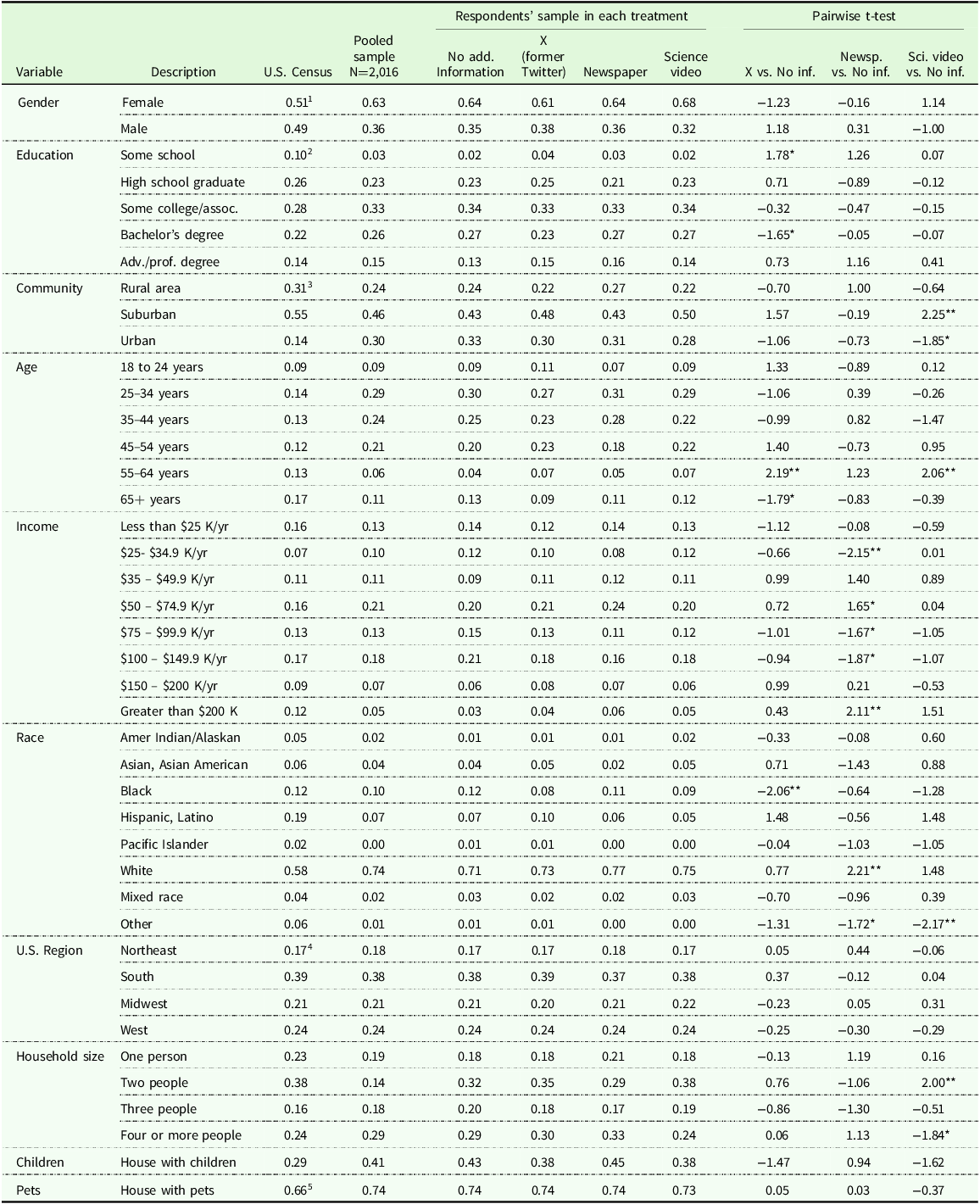
1 U.S. Census Bureau (2022). Demographic and Housing Estimates, 18-years and over.
2 U.S. Census Bureau (2022). Selected Social Characteristics in the United States. Population 25 years and over.
3 Pew Research Center (2018).
4 U.S. Census Bureau (2023). U.S. and World Population Clock.
5 Forbes (2023).
Appendix C provides summarized statistics on survey responses, focusing on questions pertinent to the latent class model. Regarding social media use, a minority (6.05%) report abstaining from any platform, with Facebook being the most utilized (51.12%), followed by Instagram (16.91%) and TikTok (10.81%), X has a lower percentage of users, with 7.68% of respondents reporting using it. Trust in information sources reveals friends/family and individual farmers as most trusted, while social media platforms garner lower trust, with YouTube ranking highest (3.02) and TikTok lowest (2.42).
In relation to attitudes towards animal welfare, respondents show consensus in that the food they eat is produced in a way that respects animal rights and does not cause pain to animals. There is also a high level of agreement that increased regulation of the treatment of animals in farming is needed, and that animal agriculture raises serious ethical questions. Respondents are concerned about the potential impact of stress on the quality of meat, milk, eggs, and sub-products. However, there is less agreement about the use of gene editing to reduce the risk of injury or disease in farm animals, with some respondents indicating that it should be forbidden even if it could improve animal welfare. Overall, the data suggest concern about animal welfare and a desire for more ethical and humane treatment of animals in agriculture (Appendix C).
Generalized multinomial logit model (GMNL-II) results
The results of the generalized multinomial logit model GMNL-type IIFootnote 9 for each of the four information treatments are presented in Table 3. The base case to which we compare is “unspecified” milk that is not labeled as either coming from dehorned cows or from gene-edited cows to prevent painful dehorning. Note that although the milk that is sold in grocery stores is unspecified in this regard, it almost always comes from dehorned cows. Thus, in this sense, the milk labeled as coming from dehorned cows is no different from the milk that consumers currently buy. Also, the WTP for gene-edited to prevent painful dehorning is lower than dehorned, indicating that even though pain mitigation is involved consumers are still willing to discount for gene-edited cows.
Table 3. Generalized multinomial logit model type II estimates by information treatment
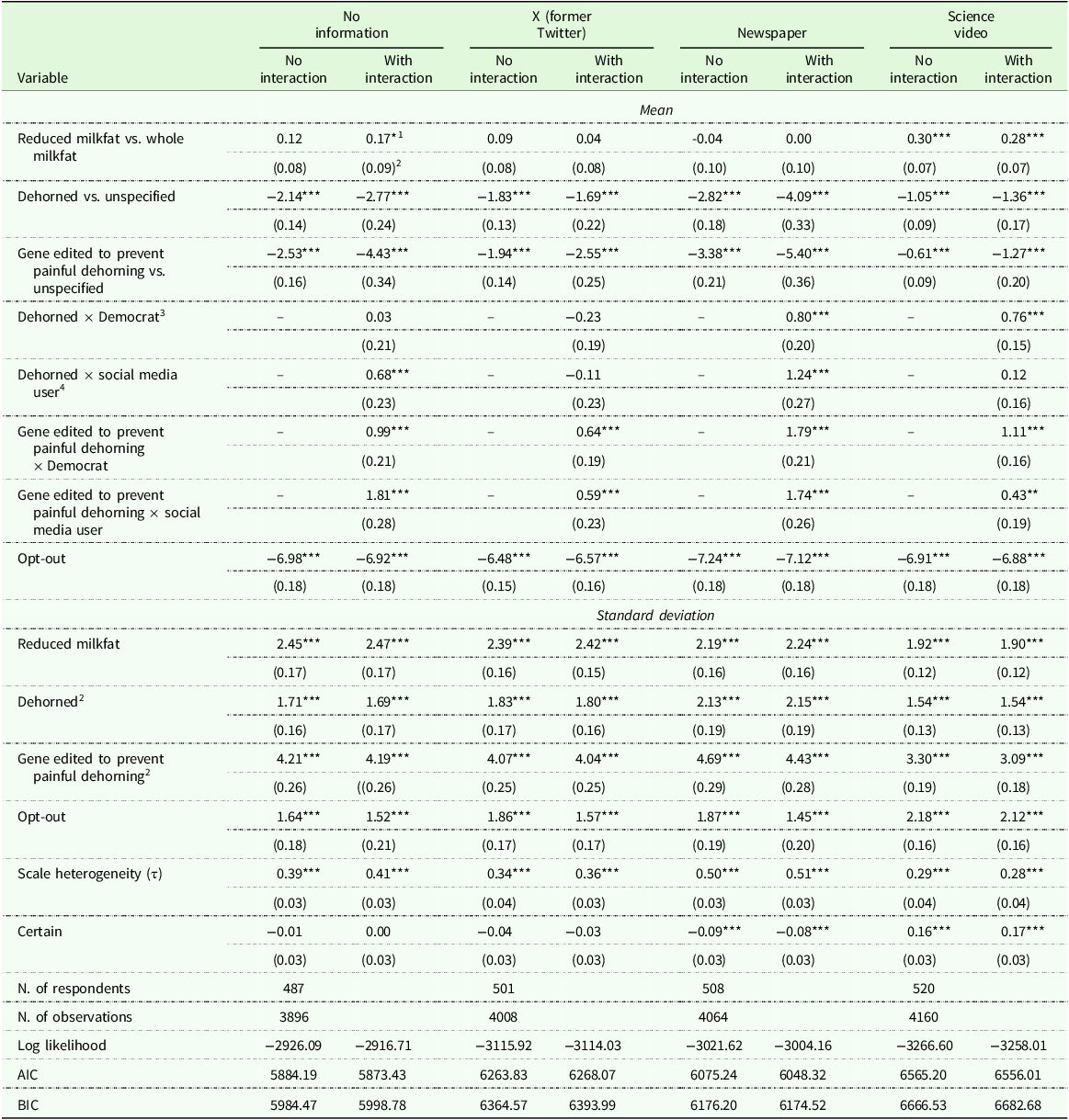
1 Single, double, and triple asterisks (*, **, ***) indicate statistical significance at the 10%, 5%, and 1% levels.
2 Standard errors are in parentheses.
3 Democratic if the respondent identifies as always Democratic
4 Regular social media user if the respondent reports using social media at least once per day.
We present WTP results across all information treatments. We acknowledge that given the inclusion of genuine excerpts from media and social media, we cannot attribute the information channel itself as the cause for differences in WTP. It is a composite of factors associated with each channel that is influencing these differences, such as the tone of the narrative used in each channel, the way the information is presented, the individual who posted the tweet, the number of retweets, the use of graphics, and so on. Across all information treatments and compared to the unspecified label, respondents require a discount (negative WTP) for both milk labeled that comes from cows that were dehorned and milk that comes from cows that were gene edited to prevent painful dehorning. The science video and newspaper information treatment results are different from the no information but in opposite directions (see Table 3). We anticipated this, because the science video offers the scientists’ perspective, while the newspaper excerpt displays a questioning and somewhat negative tone towards gene editing, which is typical of traditional media coverage of new technology (McCluskey et al., Reference McCluskey, Kalaitzandonakes and Swinnen2016).Footnote 10
The respondents who watched the science video require a discount of -$0.61 to choose milk from cows that were gene-edited to prevent painful dehorning relative to the unspecified label and a baseline WTP of $4.29/gallon. For the same attribute, the discount was -$3.38 for those who received the newspaper treatment, −$2.53 for those who responded to the control (no additional information), and −$1.94 for those who received the X post treatment. Similarly, respondents who watch the science video stated a −$1.05 discount to choose milk from dehorned cows, while those who received the newspaper treatment exhibited a discount of −$2.82, those who responded to the control discounted −$2.14 and those who were presented the X post discounted −$1.83.
Given our experimental design, it is impossible to disentangle the effects of other factors associated with each communication channel, therefore we cannot draw conclusions. However, it is important to highlight that regardless of the information treatment presented, one observes a larger discount for milk from cows that were gene edited to prevent painful dehorning compared to milk from dehorned cows.
Further, we include interaction effects for the attributes dehorned and gene edited to prevent painful dehorning with the variables: Democrat (binary variable =1 if the respondent always identifies as a Democrat, and zero otherwise) and social media user (binary variable =1 if the respondents use social media at least once per day, and zero otherwise). These interaction effects provide some interesting results. The interactions between dehorned and Democrat are only statistically significant for the newspaper and science video information treatments. The interactions between dehorned and social media user are statistically significant for the control treatment and the newspaper treatment. All interactions are statistically significant for gene edited to prevent painful dehorning. All of the statistically significant interactions are positive, which means that they reduce the negative value of the attribute. Still, for all cases except for the science-video information treatment when the respondent is both a Democrat and social media user, the net WTP for the gene edited to prevent painful dehorning combined with the interactions is still negative relevant to unspecified milk. For all cases, the WTP net of interactions for milk from dehorned cows is negative.
Our results are consistent with Kilders and Caputo (Reference Kilders and Caputo2021), who find that WTP increases for milk from gene-edited cows when scientific or positive information is offered. Their information treatments start with no information (the control), then add facts about gene editing and differences with genetically modified organisms, and then add information about animal welfare benefits that can be achieved with gene editing. In our study, the WTP for milk from cows that were gene edited to prevent painful dehorning increases relative to no-information for the information treatments that used a positive tone. Different from Kilders and Caputo (Reference Kilders and Caputo2021), we also included an actual newspaper information treatment, which had a more skeptical tone and as expected the impact of the newspaper article is negative on the WTP.
In relation to other attributes included in the discrete choice scenarios, across three of the four information treatments, there are no statistically significant differences in the WTP for reduced-fat versus whole-milk fat. Only the respondents in the science video information treatment are willing to pay $0.30 per gallon more for 2% milk fat compared to whole milk. These results are somewhat different from Brooks and Lusk (Reference Brooks and Lusk2010) where they estimated that individuals in their sample were -on average- willing to discount for whole milk compared to skim milk.
Latent class model results
For the latent class analyses, the study only focuses on the control information treatment (no-additional information), to avoid confounding effects with the information-treatment effects. The latent-class model results are presented in Table 4 and the predictors of class membership, relative to the base case, are presented in Table 5 Class 1 is the baseline group and includes 25.31% of the respondents in the control group. Class-1 members have negative valuations for both milk from dehorned cows (−$2.44) and from cows who were gene edited to prevent painful dehorning (−$2.69). This class is the most sensitive to price.
Table 4. Latent class model results
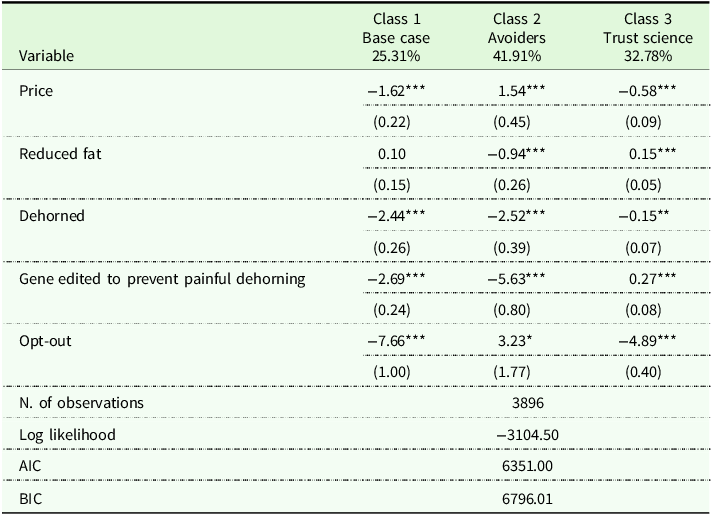
Note: Standard errors are in parentheses. The baseline is Milkfat whole. The baseline is No indication of whether the cow was dehorned. Single, double, and triple asterisks (*, **, ***) indicate statistical significance at the 10%, 5%, and 1% levels.
Table 5. Variables predicting class membership (Class 1, the base case, is omitted)
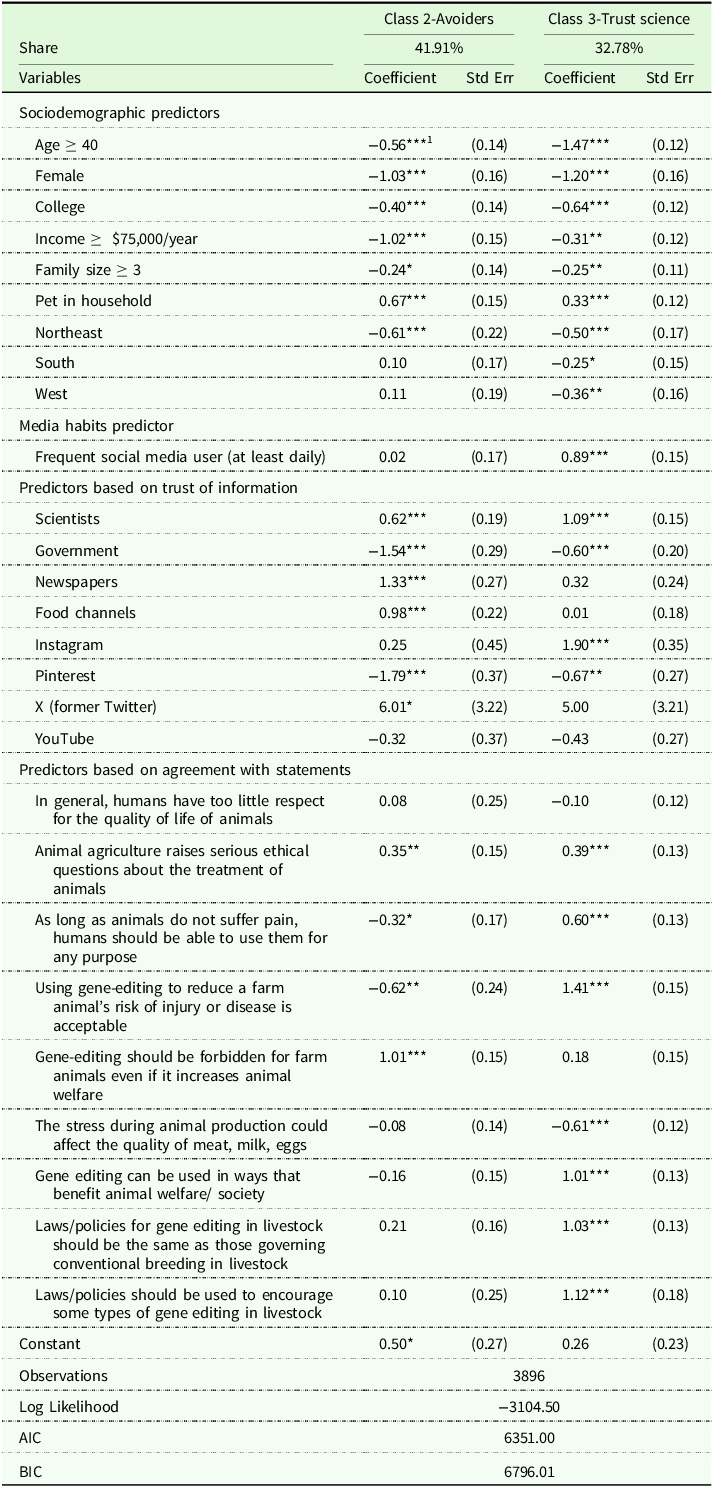
1 Single, double, and triple asterisks (*, **, ***) indicate statistical significance at the 10%, 5%, and 1% levels.
Class 2 respondents constitute 41.91% of the respondents in control treatment group. We call them the “avoiders” because they require the largest discount (i.e., negative WTP) for milk from cows that were gene edited to prevent painful dehorning at −$5.63, which is greater than the highest price of milk in our choice experiment ($4.89), and the largest discount for milk from dehorned cows (−$2.52). They have a positive value for the opt-out choice. This segment prefers whole over reduced-fat milk. This group exhibits a positive coefficient estimate for price.
Relative to the base class, the avoiders (class 2) have fewer members who are older than forty years old, female, hold a college degree, have an income above $75,000, and live in the northeastern United States. The avoiders are more likely to have a pet in their household. They exhibit a larger proportion of individuals who have higher trust in information from newspapersFootnote 11 and food channels for traditional media and X for social media. They have positive but modest trust in scientists. This group has the lowest trust in information that comes from the government.
The avoiders include a smaller proportion of individuals -compared to the base- who agree with the idea that humans can use animals for any purpose as long as the animals do not suffer pain. This group also contains a smaller proportion of individuals who approve of the use of gene editing to reduce the risk of injury in animals. Conversely, the avoiders include a larger proportion who believe that gene editing should not be allowed for farm animals, even if it could enhance animal welfare and that animal agriculture poses serious ethical questions regarding the treatment of animals. In summary, the avoiders show interest in improving animal welfare but are very against the use of gene editing perhaps relating it to ethical issues.
Class 3 members constitute 32.78% of the sample of respondents in the control group. We can call this class the “trust science” group. They are the only class who indicate that they are willing to pay a premium for milk from cows that were gene edited to prevent painful dehorning ($0.27). They also have smallest negative WTP for milk from cows who are dehorned (−$0.15). They are less sensitive to price relative to Class 1. This segment favors reduced-fat over whole-fat milk, and the options with attributes over opting out.
The trust-science class is somewhat like the avoiders in terms of sociodemographic characteristics with the differences mostly in terms of age, trust science, have considerably less proportion of individuals older than 40. These results are aligned with Uddin et al. (Reference Uddin, Gallardo, Rickard, Alston and Sambucci2022) who found that males, young and hold a bachelor’s degree were more likely to pay a premium for gene-edited grapes. The predictors for all regional variables are negative and significant, which points to the science-trust class being more likely from the U.S. Midwest region (the omitted category). This group has the largest proportion of respondents who trust science-originated information, in greater magnitude than the avoiders. This is similar to Uddin et al. (Reference Uddin, Gallardo, Rickard, Alston and Sambucci2022) who found that those willing to pay a price premium for gene-edited grapes were the most trusting in science. Relative to the base case, they have a lower proportion of those who have high trust in information from government but not as extreme as the avoiders (class 2). However, different from the avoiders, the trust-science class has a larger proportion of individuals who have higher trust in information from Instagram.
Like the avoiders, the trust-science class has a larger proportion of individuals who agree that animal agriculture raises serious ethical questions about the treatment of animals. Different from the avoiders, the trust-science class has a larger proportion of individuals who agree that animal agriculture raises ethical questions about the treatment of animals and that animals can be used for various purposes without causing them suffering. This group has a larger proportion of individuals who agree in the use of gene editing to minimize risk of injury or disease, that gene editing could be used to benefit animal welfare and society, and that policies should encourage the use of gene editing in livestock. However, this group has less proportion of individuals who agree that stress in animals could affect the quality of animal products.
In sum, both avoiders and the trust-science group are concerned with animal ethical treatment, yet they diverge on key issues. The avoiders oppose using animals for any purpose, even if the animals do not suffer, while the trust-science group is in favor. The main point of contention between these two groups lies in their views on gene editing, specifically regarding its role in enhancing animal welfare.
Conclusions and implications
In this study, we investigated consumer responses to information about milk that comes from cows who are dehorned, hornless by gene editing to prevent painful dehorning, or unspecified. We find that consumers’ WTP for milk generally decreases with labeling that the cows were dehorned, which is the case for almost all commercially available milk, or that the cows were gene edited to prevent painful dehorning. That is, overall, consumers’ WTP is the highest for milk with no indication of coming from either dehorned cows or cows that were gene edited to prevent painful dehorning. We note that the status quo in U.S. milk sales is that it comes from dehorned cows, but the milk is not labeled as such. Thus, we expect that the average consumer is unlikely to know about dehorning. The consumers surveyed in this study, prefer to avoid products with information about whether cows they dehorned or treated with new technologies to prevent painful dehorning.
In addition, we applied information treatments to sub-groups of our respondents. The information treatments included (1) a control with no-additional information, (2) excerpts from a Washington Post newspaper article, (3) postings from X, and (4) science video on the topic, which was created by the purposes of the wider study of which this article is a component. We find that the tone of the information treatments has differential effects on the choice of milk from cows that were gene edited to prevent painful dehorning, with the science video having the largest positive impact. The excerpts from the newspaper article had a negative impact.
One limitation of this study is that we considered only either positive or negative perspectives from each type of information source. Ideally, we should have incorporated both positive and negative viewpoints from the same source, and control for the name of the person posting, number of re-tweets, length of the information presented, graphical presentation and so on. By doing so, we could better discern which sources exert a greater influence on specific demographics, independent of the content’s tone.
This study has two implications. First, consumers often demand information about their food based on health, nutrition, environmental impact, social, and ethical concerns. This transparency, often required by law, can be a double-edge sword because it could reveal practices that consumers find distressing. This study shows that the sample of respondents preferred the product without information on the treatment of dairy cows. The policy implication is that if consumers show they are willing to pay for no-information, then policies mandating labeling production methods do not enhance consumer welfare.
Second, foods made with new technologies, such as gene editing, may be beneficial to animal welfare, the environment, and/or human health, their potential benefits can only be fully realized if embraced by consumers. Even if consumers would prefer to avoid uncomfortable information about food production methods, transparency in communicating science is of primal importance. Our results suggest that scientists are trusted for information to a greater degree than other entities. As such, it is important to use creative ways for scientists to promote acceptance of food products made with new technologies. The benefits of these new technologies should be communicated to consumers in formats that they use, especially social media. In a study on social media influencers with X data, Navelski et al. (Reference Navelski, Badruddoza and McCluskey2023) finds that anti-gene-editing influencers have more followers and command more influence. Therefore, there is a need for influencers who can play the role of “science ambassadors”. It follows that science communication to the public should be a required component in publicly funded agricultural research.
Overall, our study suggests that consumers generally view both dehorning cows and the use of gene editing negatively. Dehorning may evoke a sense of guilt and discomfort in consumers over animal suffering. Gene editing, on the other hand, raises concerns due to the risks associated with new breeding technologies. When given a choice, consumers are likely weighing their discomfort with animal suffering against their apprehension about the safety or ethics of gene editing. Further research should delve into the impact of different communication channels and styles to improve consumers’ acceptance of new technologies.
Supplementary material
The supplementary material for this article can be found at https://doi.org/10.1017/age.2025.14
Acknowledgments
We acknowledge Syed Badruddoza, Patricia Glazebrook, Carolina Gonzalez-Berrios, Joseph Navelski, Alison van Eenennaam, and Jason Winfree, who are collaborators on related research, and Ruoye Yang for her research assistance.
Funding statement
This research was funded by NIFA, USDA.
Competing interests
The authors declare no competing interests.
Appendix A.
Table A1. Measures of goodness-of-fit as part of the selection criteria to identify the optimal number of segments in the latent class model

Appendix B.
Information treatments
-
1) No additional information (control group)
-
2) Traditional media. Excerpt from a Washington Post article, “Gene-edited farm animals are coming. Will we eat them?” By Carolyn Y. Johnson December 17, 2018,
“As scientists in labs across the world create virus-resistant pigs, heat-tolerant cattle and fatter, more muscular lambs, a big question looms: Will regulation, safety concerns and public skepticism prevent these advances from becoming anything more than fascinating laboratory experiments, or will the animals transform agriculture and the food supply? So far, gene-editing tools have jump-started research worldwide, creating more than 300 pigs, cattle, sheep and goats. Now, proponents of the field say the United States is at a make-or-break moment, when government action over the next year could determine whether any gene-edited food animals make it to market.”
“[At UC Davis, there] are five bulls and a heifer, the second generation of cattle that have been gene-edited to lack horns, avoiding a grisly procedure in the dairy industry called “disbudding,” when calves’ horns are burned or cut off.”
“Gene-edited plants will soon be in the grocery store, but similar tinkering with the DNA of animals faces a far more uncertain future. The regulatory process for getting animals approved is more complex and treats the edited DNA as a veterinary drug — a difference that animal scientists argue will effectively kill their field by preventing innovations that could make raising livestock more sustainable, more efficient or more humane. Many advocates and ethicists agree that the current oversight system is a poor fit but think that scientists and industry underestimate potential safety concerns.”
“‘We’re at this inflection point in society, where gene editing is really taking off, and now is the time we could have a more sustained public conversation about how we want it used in our world and how we don’t want it to be used,’ said Jennifer Kuzma, co-director of the Genetic Engineering and Society Center at North Carolina State University. ‘All the polls indicate that people are less comfortable with animal biotechnology than plant biotechnology… A regulatory system cannot be based 100% on science or scientific risk, and values come into play when setting the standards.’”
“Scientists were re-energized by the invention of new and more precise technologies, the most famous of which is CRISPR, short for clustered regularly interspaced short palindromic repeats. Using CRISPR, scientists can quickly, easily and cheaply make targeted cuts to the genome and make changes or insert new genes. Instead of introducing the foreign DNA that had triggered public skepticism, they could delete or change a single letter out of billions in an animal’s genome. Such changes happen routinely in nature — they are the basis for evolution — so scientists were hopeful that regulators and the public would see these animals differently.”
-
3) Social media. Tweets

-
4) Science video link https://youtu.be/ZUG9V9mXStU?si=cbaByti-RpeVcOgf


Appendix C. Descriptive statistics of responses to other survey questions.
Table C1. Descriptive statistics of survey respondents
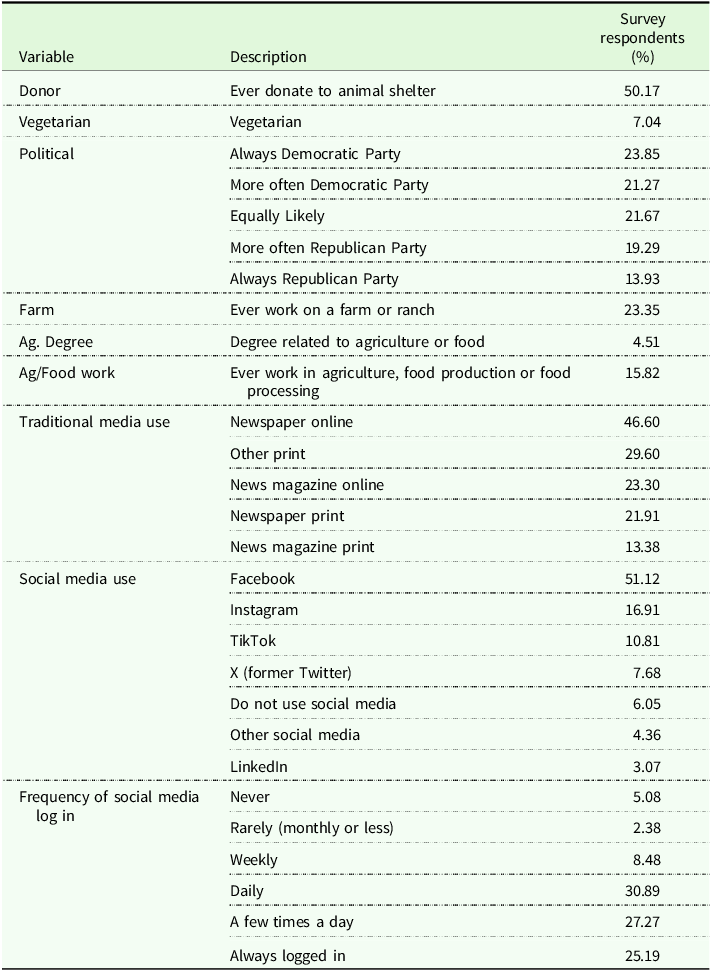
Table C2. Summary statistics on trust by information sources
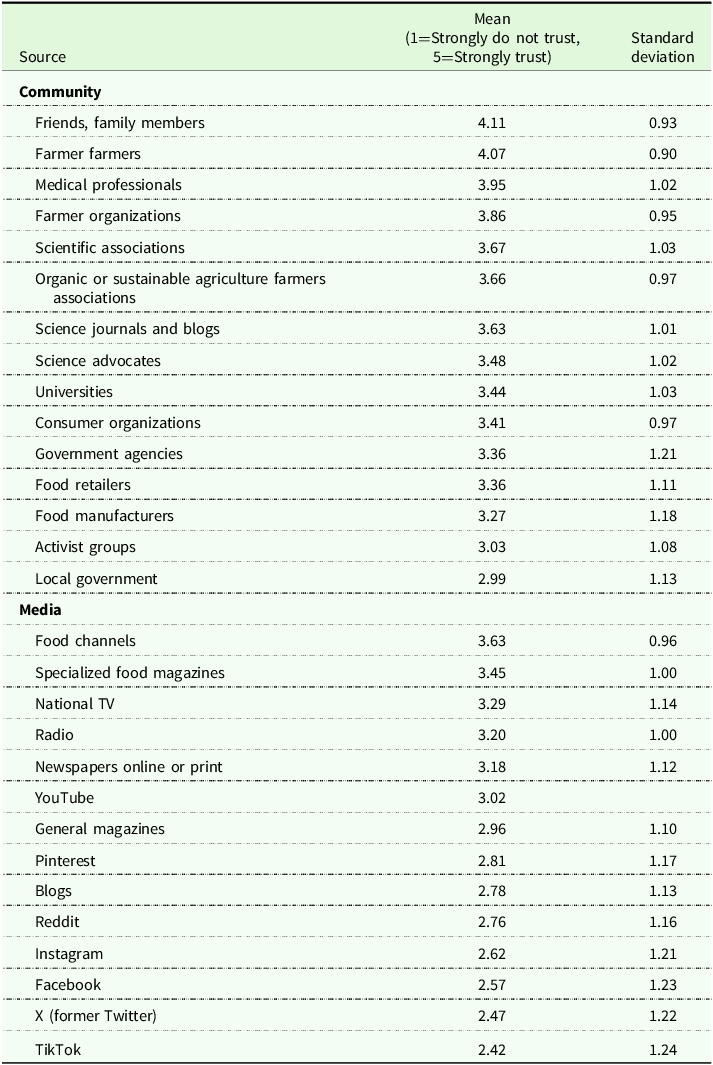
Table C3. Attitudes towards animal welfare
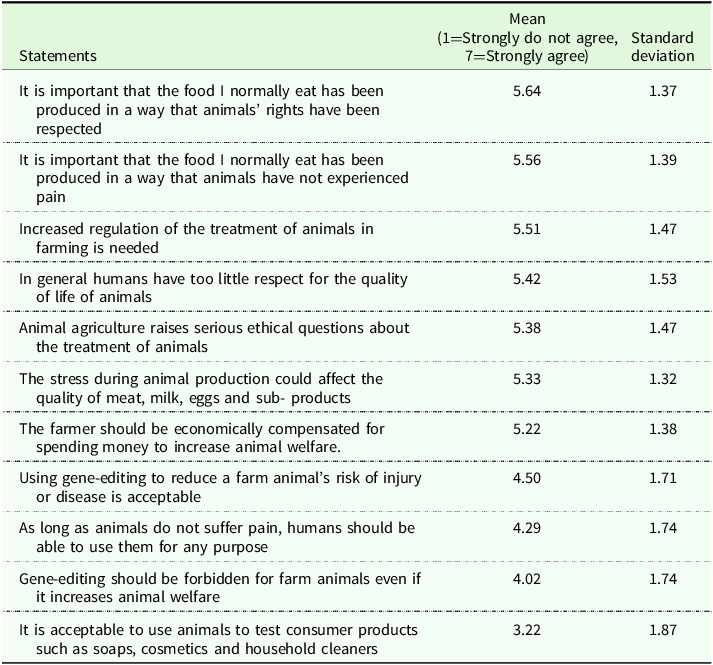
Table C4. Importance of milk characteristics
